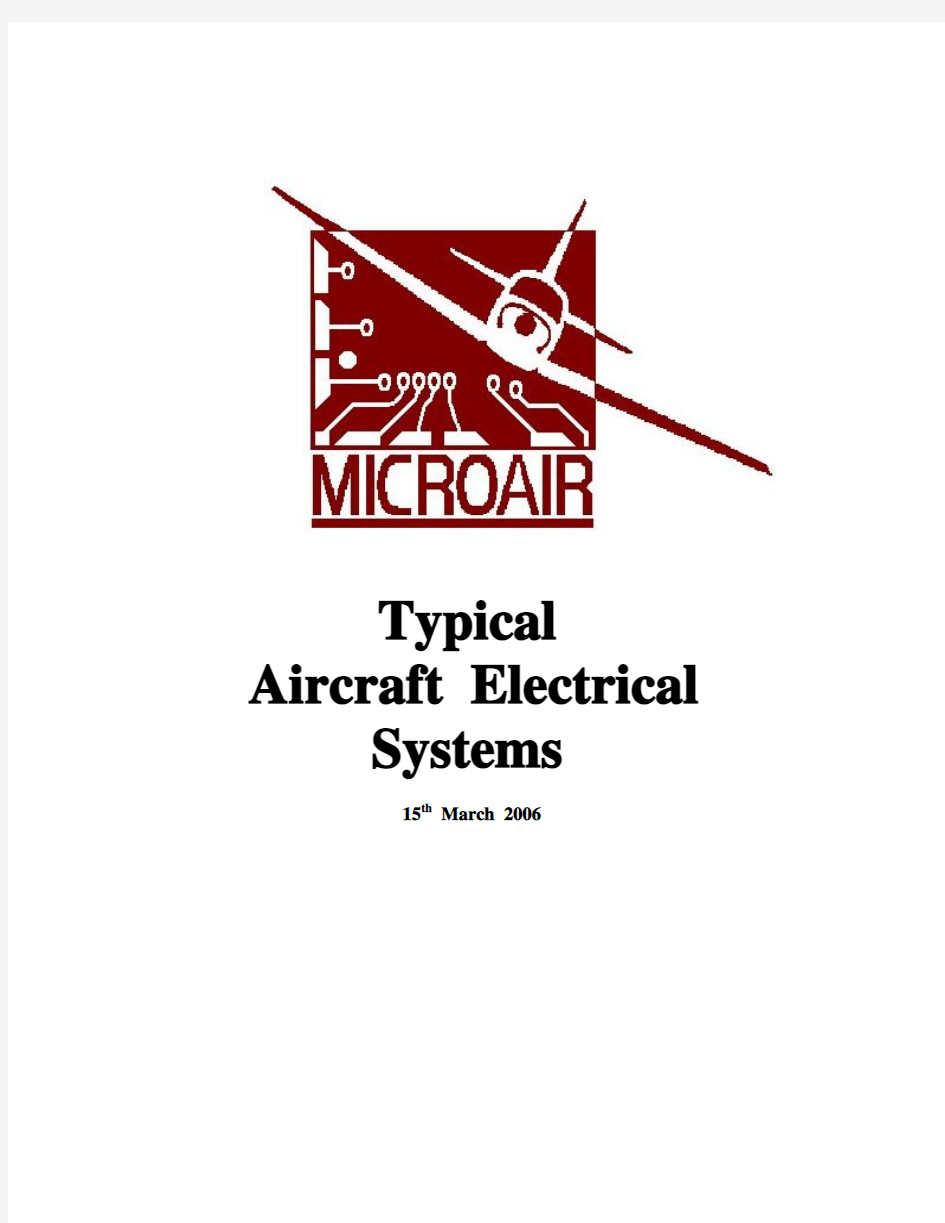典型飞机电气系统

- 1、下载文档前请自行甄别文档内容的完整性,平台不提供额外的编辑、内容补充、找答案等附加服务。
- 2、"仅部分预览"的文档,不可在线预览部分如存在完整性等问题,可反馈申请退款(可完整预览的文档不适用该条件!)。
- 3、如文档侵犯您的权益,请联系客服反馈,我们会尽快为您处理(人工客服工作时间:9:00-18:30)。
Typical Aircraft Electrical Systems
15th March 2006
ABN 92 091 040 032
+61 7 41553048 Fax: Email: Web: 07-41553049 +61 7 41553049 info@.au sales@.au .au
P O Box 5532 Airport Drive Bundaberg West Queensland 4670 Australia
Introduction
There are some important do’s and don’t’s when considering the electrical system of an aircraft. Even in cases where the aircraft kit manufacturer has supplied the hardware for the electrical system in the kit, there is often a need to “customise” the system to better suit the individuals tastes, or the requirements of extra equipment.
Electrical Load
Most aircraft builders/owners will possess a multi-meter, and will be familiar with how to measure the voltage at various points in the electrical system. A voltage measurement by itself does not however determine the LOAD at that point. To do this the current must be measured. Most multi-meters will do this, but to take the measurement, the circuit must be opened, and the multi-meter inserted in series with the circuit. The electrical load must be known to build the electrical system from the correct materials. Wiring has a load rating normally quoted as a maximum number of AMPS. Switches and circuit breakers also have load ratings in their specifications. IMPORTANT It is vital that the components of your electrical system have load ratings which exceed the worst case electrical load which the components are expected to bear. If the electrical load draws 5 Amps, then the wiring must be rated above 5 Amps.
Wiring is usually described in terms of its “gauge”. The most commonly used scale is American Wire Gauge (AWG). This scale has a corresponding electrical load rating. Before you can determine the appropriate AWG for the various lines in your electrical system, the length of each wire must be considered. AC.43-13-1B is an advisor circular issued by the FAA, which has grown over the years to become a substantial book of how to repair most types of airframe. Section 13 describes the wiring needs for aircraft systems, and relates the electrical load a wire must bear, to the maximum length over which it is safe for that wire to carry such a load. It is possible for small wires to carry large currents for short lengths, the longer the length required the larger the wire gauge must become. You need to consider:
Wiring
What is the load on the wire ? What is the length of the wire ?
…and from this determine…
What should the gauge of the wire be ?
Microair Avionics
ABN 92 091 040 032
+61 7 41553048 Fax: Email: Web: 07-41553049 +61 7 41553049 info@.au sales@.au .au
P O Box 5532 Airport Drive Bundaberg West Queensland 4670 Australia
Electrical wire is clad in insulation. Most people will be familiar with conventional plastic insulation which is in common use in houses, cars, boats etc. Aircraft present a unique situation which the above applications don’t have. In the case of a fire, you cannot run away, you cannot follow an evacuation plan (unless you are wearing a parachute). You are forced to stay at the scene of the fire until you can land, or extinguish the fire. Where there is fire there is smoke… All things burn, it just depends on the required temperature. Once on fire, all things give off smoke or fumes. The smoke and fumes in most cases are toxic in concentrated quantities. If you are trapped in an enclosed cockpit at the scene of a fire, there is a serious risk of being asphyxiated by the smoke or fumes. It is very important to select wire with an insulation which resists fire, does not support the spread of fire, and most importantly, does not give off smoke or fumes. There are a variety of lesser known MIL-Spec wires which have been designed with very high fire ratings. Most comply with Military Specification M22759/16-xx where the xx is the AWG size of the wire. This wire spec is available in 10 colours including white.
Insulation
Most General Aviation (GA) aircraft are wired with white wire. The wiring is typically labelled at regular intervals to make identification easy. The single colour option can save money, because you can order a larger quantity of just one part number, instead of small quantities of many part numbers. Despite this, Microair recommends that you establish a colour code for your aircraft and stick to it. By the time you have finished wiring the instrument panel in a single colour you will be struggling to identify one wire from another. Many Avionics manufacturers offer a colour code in their installation manuals. Microair recommends that you follow their advice. It can be very expensive in some cases to cross wires over, and then turn the unit on. We have a large number of sad stories on file, which have this scenario as a theme. The most common of all colour codes is:
Colour Code
Red – positive Black – negative
Microair Avionics
